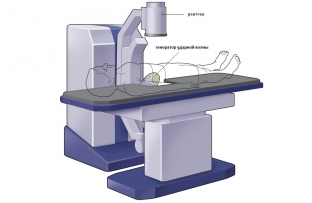The treatment of urolithiasis is one of the most pressing issues in modern urology and medicine in general. There are many conservative and surgical ways to rid a person of kidney stones, each of which has its own disadvantages and advantages. The goal of any of these methods is to remove the stone from the urinary tract as quickly, painlessly and effectively as possible. To date, one of the most effective methods of treating urolithiasis is remote shock wave lithotripsy – non-invasive stone crushing.
External shock wave lithotripsy removes kidney stones
External shock wave lithotripsy is currently one of the most promising methods for the treatment of urolithiasis. The essence of remote lithotripsy is the non-invasive crushing of stones in the urinary tract, that is, crushing occurs without direct contact with the stone. The stone that has undergone lithotripsy subsequently passes out with urine without any problems, without causing pain to the patient and preventing the occurrence of complications, the development of which is possible when using other methods of treating urolithiasis.
External shock wave lithotripsy:
- main types of shock wave lithotripters;
- indications for shock wave lithotripsy;
- contraindications for shock wave lithotripsy;
- shock wave lithotripsy technique.
The main types of shock wave lithotripters
Today, more than 40 types of lithotripters are used in the world, the most widely used of which are three main methods of generating shock waves:
- electrohydraulic lithotripters form shock waves as a result of a high-voltage discharge in water between pairs of electrodes located on the spark gap. Shock wave guidance is performed under X-ray or ultrasonic control. Such lithotripters allow you to get a powerful shock wave in excess of 1300 bar;
- electromagnetic lithotriptors make it possible to form a shock wave in a special shaper and focus it on a calculus using an acoustic lens system. The guidance of the wave on the stone is also controlled by X-ray or ultrasonic devices;
- piezoceramic lithotripters are the newest to date, have a complex structure mechanism and allow absolutely painless crushing of stones in the patient's body. At the same time, piezoceramic lithotripters are not effective against very large and hard calculi.

Indications for shock wave lithotripsy
External shock wave lithotripsy is possible if a patient with urolithiasis has indications for this procedure. There are such main indications for shock wave lithotripsy:
- single kidney stones up to 25 mm in size, provided there are no urinary outflow disorders below the stone;
- multiple kidney stones with a total size of up to 30 mm.;
- One or two stones in the ureter, up to 10 mm in size. in the absence of a pronounced expansion of the upper urinary tract and an active form of chronic pyelonephritis;
- coral-like kidney stones with a total size of up to 40 mm.
Contraindications for shock wave lithotripsy
There are also contraindications to performing extracorporeal shock wave lithotripsy, the main of which are:
- impossibility of visualization and precise aiming of the stone under the shock waves;
- obstruction of the urinary tract below the level of localization of the stone;
- severe spinal deformity;
- blood coagulation disorders;
- pregnancy;
- gross violations of cardiovascular activity;
- splenomegaly;
- oncological pathology;
- acute inflammatory processes in the body;
- active TB;
- sepsis;
- acute obstructive pyelonephritis;
- impaired secretory function of the kidney as a result of its wrinkling.
Shock wave lithotripsy technique
Preparing the patient for shock wave lithotripsy consists of cleansing and reducing intestinal pneumatization, which allows you to visualize the calculi as well as possible. During the procedure, the patient should be on his back or on his stomach. Crushing starts with low-energy modes – 500-600 pulses, with inefficiency, the number of pulses is increased. Crushing of stones in the renal pelvis and ureters is performed on a pre-installed stent. As a result of the impact of the shock wave on the calculus, it splits into small fragments, which subsequently, together with the urine of a painless person, leave the patient's body.







Add a comment